
Lichenology is the branch of mycology that studies the lichens, symbiotic organisms made up of an intimate symbiotic association of a microscopic alga with a filamentous fungus.

Erik Acharius was a Swedish botanist who pioneered the taxonomy of lichens and is known as the "father of lichenology." Acharius was famously the last pupil of Carl Linnaeus.

A bioindicator is any species or group of species whose function, population, or status can reveal the qualitative status of the environment. The most common indicator species are animals. For example, copepods and other small water crustaceans that are present in many water bodies can be monitored for changes that may indicate a problem within their ecosystem. Bioindicators can tell us about the cumulative effects of different pollutants in the ecosystem and about how long a problem may have been present, which physical and chemical testing cannot.

Xanthoria parietina is a foliose lichen in the family Teloschistaceae. It has wide distribution, and many common names such as common orange lichen, yellow scale, maritime sunburst lichen and shore lichen. It can be found near the shore on rocks or walls, and also on inland rocks, walls, or tree bark. It was chosen as a model organism for genomic sequencing by the US Department of Energy Joint Genome Institute (JGI).

Ramalina fraxinea, the cartilage lichen, is a fruticose lichen with erect or pendulous thalli and branches that are flattened. Colour varies from pale green though yellow-grey to white-grey; apothecia are frequent and soralia may also be present.

Ramalina is a genus of greenish fruticose lichens that grow in the form of flattened, strap-like branches. Members of the genus are commonly called strap lichens or cartilage lichens. Apothecia are lecanorine.

The Caliciaceae are a family of mostly lichen-forming fungi belonging to the class Lecanoromycetes in the division Ascomycota. Although the family has had its classification changed several times throughout its taxonomic history, the use of modern molecular phylogenetic methods have helped to establish its current placement in the order Caliciales. Caliciaceae contains 36 genera and about 600 species. The largest genus is Buellia, with around 300 species; there are more than a dozen genera that contain only a single species.
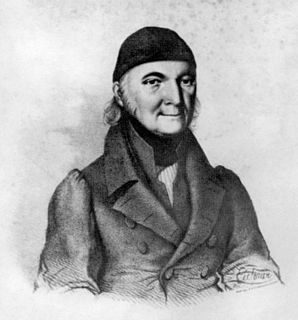
Heinrich Gustav Flörke was a German botanist and lichenologist. The standard author abbreviation Flörke is used to indicate this person as the author when citing a botanical name.
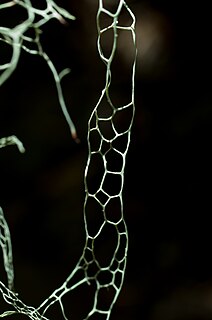
Ramalina menziesii, the lace lichen or fishnet, is a pale yellowish-green to grayish-green foliose lichen. It grows up to a meter long, hanging from bark and twigs in a distinctive net-like or lace-like pattern that is unlike any other lichen in North America. It becomes a deeper green when wet. Apothecia are lecanorine. it is an important food source for deer in the Coast Range of California, and a source of nest material for birds. It is highly variable in its growth form, with branches sometimes so slender as to appear like strands, sometimes tiny, and sometimes large with broadly flattened branches.
Vermilacinia ceruchis is a fruticose lichen found on sand and rock in coastal fog areas of Peru and Chile.
Thomas Hawkes Nash III is an American lichenologist. His research is about the biology and ecology of lichens, and the effects of air pollution on plants and lichens. He is known as an authority on the family Parmeliaceae. During his long career at the Arizona State University, he helped develop the lichen herbarium into a world-class collection with over 100,000 specimens representing more than 5000 species. In 2010, the year of his retirement, he was awarded the Acharius Medal for lifetime achievements in lichenology, and the following year had a Festschrift published in his honor.
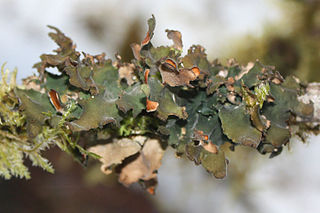
Nephroma resupinatum, commonly known as the pimpled kidney lichen, is a species of foliose lichen in the family Peltigeraceae. It was first described by Carl Linnaeus in his 1753 work Species Plantarum as Lichen resupinatus. Erik Acharius transferred it to the genus Nephroma in 1810.
Punctelia ulophylla is a species of foliose lichen in the family Parmeliaceae. It is found in Europe, where it grows on the bark of a variety of trees.

Lepraria incana is a species of dust lichen in the family Stereocaulaceae. First described scientifically by Johann Jacob Dillenius in 1741, and then formally by Carl Linnaeus in 1753, it is the type species of the genus Lepraria. The thallus of this species is green to greyish-green, and powdery – as if made of tiny granules. These granules are soredia, which are asexual reproductive structures. Like most members of genus Lepraria, the lichen has few distinguishing features, lacking both a medulla and sexual reproductive structures (apothecia). Chemically, the lichen is characterised by the presence of the secondary chemicals known as divaricatic acid and zeorin.
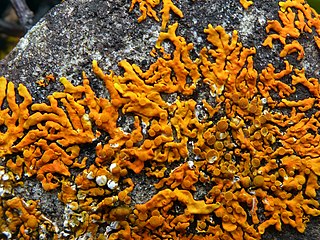
Dufourea is a genus of mostly foliose lichen species in the subfamily Xanthorioideae of the family Teloschistaceae. Species in the genus are found in the Southern Hemisphere.

Salazinic acid is a depsidone with a lactone ring. It is found in some lichens, and is especially prevalent in Parmotrema and Bulbothrix, where its presence or absence is often used to help classify species in those genera.

Gowardia nigricans, commonly known as the gray hair lichen or gray witch's hair, is a species of fruticose lichen in the family Parmeliaceae.

Ramalina americana, commonly known as the sinewed ramalina, is a pale green fruticose lichen that is found across the Northern US Midwest, extending into Southern Canada and the Eastern Seaboard. It is characterized morphologically by the presence of pseudocyphellae, straight spores, and its unique chemical diversity.
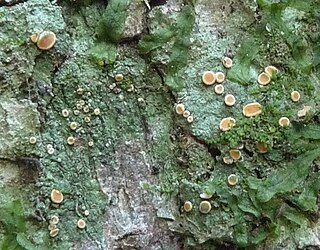
Coenogonium pineti is a species of crustose lichen in the family Coenogoniaceae. It was first formally described by Erik Acharius in 1810, as Lecidea pineti. Robert Lücking and H. Thorsten Lumbsch transferred it to Coenogonium in 2004 after molecular phylogenetic analysis suggested its placement in that genus. The lichen has a widespread distribution in cooler, temperate regions of the Northern Hemisphere, but has also been recorded from southeastern mainland Australia and Tasmania.















